Topic Model User Evaluation
Project description
# Topiceval
Topiceval is a python library with functionalities to learn topic models (namely gensim LDA, Thresholded SVD, Sparse Coding - Sparse Dictionary Learning) over user mails stored in Outlook with an end interface for user-study on topic quality evaluation, as well as providing topic model classes for usage on independent data-sets.
Added functions include ability to run diagnostics on learned models, which include visualizations on topic-document distribution, topic entropy matrix, topic weights required to cross thresholds etc.
# Requires
- python 3.x or python >= 2.6
- For user-email evaluation - Windows and Outlook
# Dependencies
- scipy>=0.19.0
- gensim
- numpy
- matplotlib
- pandas
- scikit-learn
- nltk (optional)
# Installation
$ pip install topiceval
or
Download from source and "$ python setup.py install" (not yet tested)
# Usage
## User Email Study
$ python -m topiceval
You can also add options:
- -numtopics <int>: Number of topics to learn
- -usethreads <0/1>: Whether to treat each message in threaded conversation as different document (0) or not (1)
- -uselemma <0/1>: Whether to lemmatize words, set to 1 only if you have downloaded wordnet corpora for nltk package.
- -numtopicseval <int>: How many topics out of the learned ones to be shown to the user for evaluation.
- excludefolders <str>: Comma separated name of folders to exclude during mail extraction
- makeWtsvd <0/1>: Whether to make W matrix for TSVD, setting at 1 not yet tested
For example, to learn 20 topics from user mails using lemmatization, excluding folders named 'private' & 'work', and displaying 10 topics for evaluation, you have to use:
$ python -m topiceval -numtopics 20 -numtopicseval 10 -excludefolders private,work -uselemma 1
### User Evaluation Interface
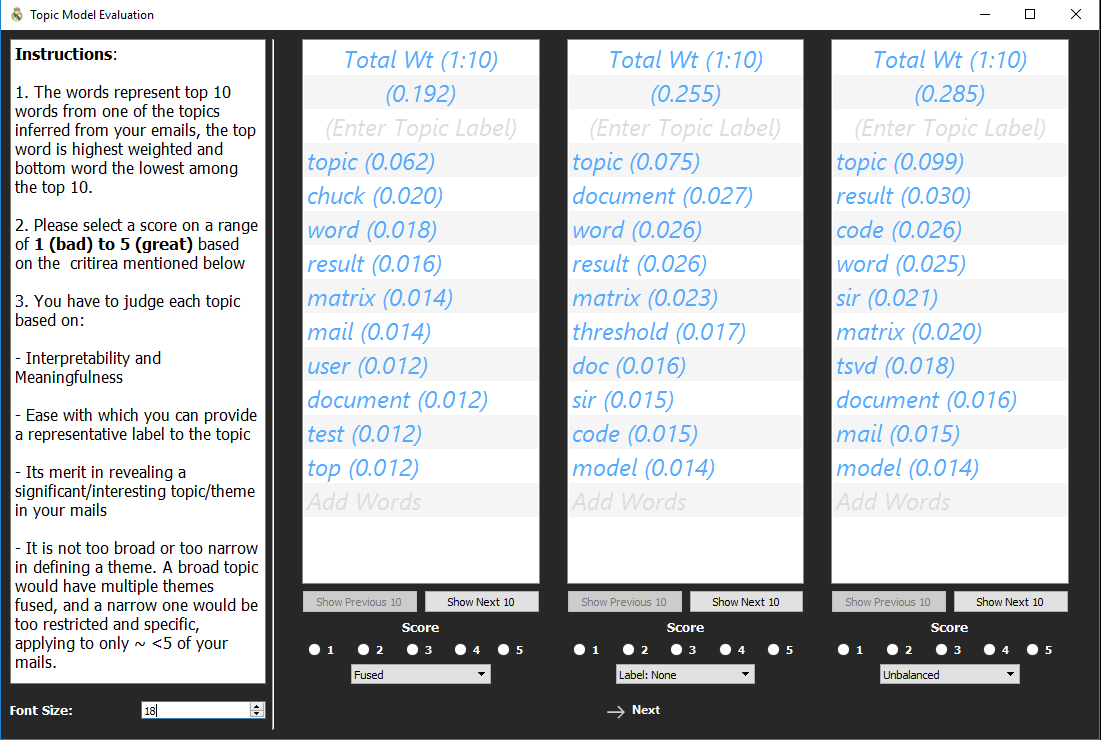
## TSVD Topic Model
### Case 1
You have the docword file and vocab file.
"docword file" is in the format *doc_id word_id word_freq* per each line. Both *doc_id* and *word_id* are 1-indexed
"vocab file" has a vocabulary word in each line, where line number is the word_id.
from topiceval.thresholdedsvd.tsvd import TSVD
model = TSVD(docword_filepath="<your_docword_filepath>", vocab_filepath="<your_vocab_filepath>", num_topics = 20)
learned_M_matrix = model.M_matrix
topic_catchwords = model.topicwise_catchwords
model.save_topic_top_words(filename="tsvdtopics.txt")
model.plot_topic_topwords(topicid_list=range(10))
model.plot_entropy_distribution()
model.plot_topic_entropy_colormap()
model.save_M_matrix(filename="<desired_filepath>")
### Outputs
The following are outputs for TSVD models on NIPS dataset from UCI BoW repository
- Snap from text file made by model.save_topic_topwords:
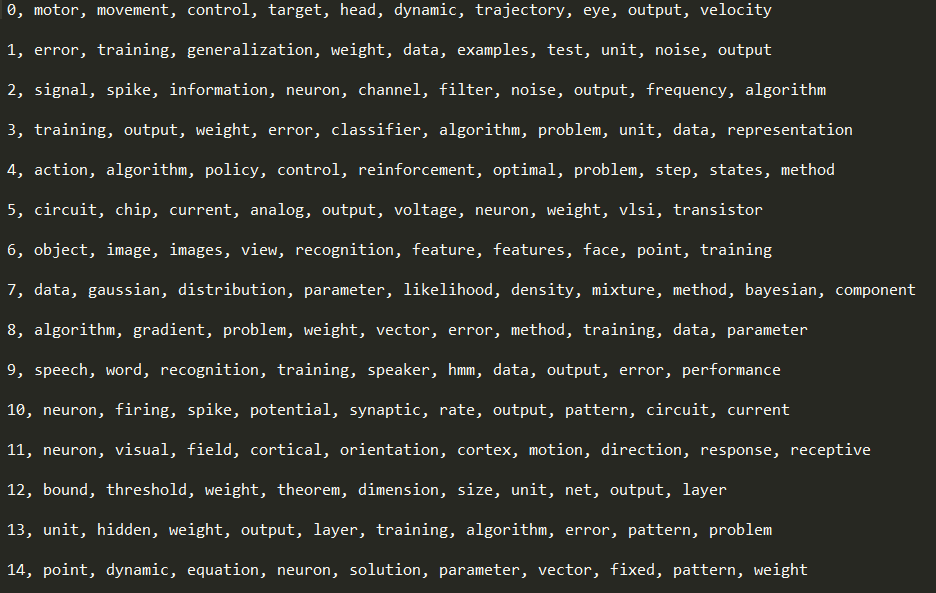
- Plot from model.plot_topic_topwords
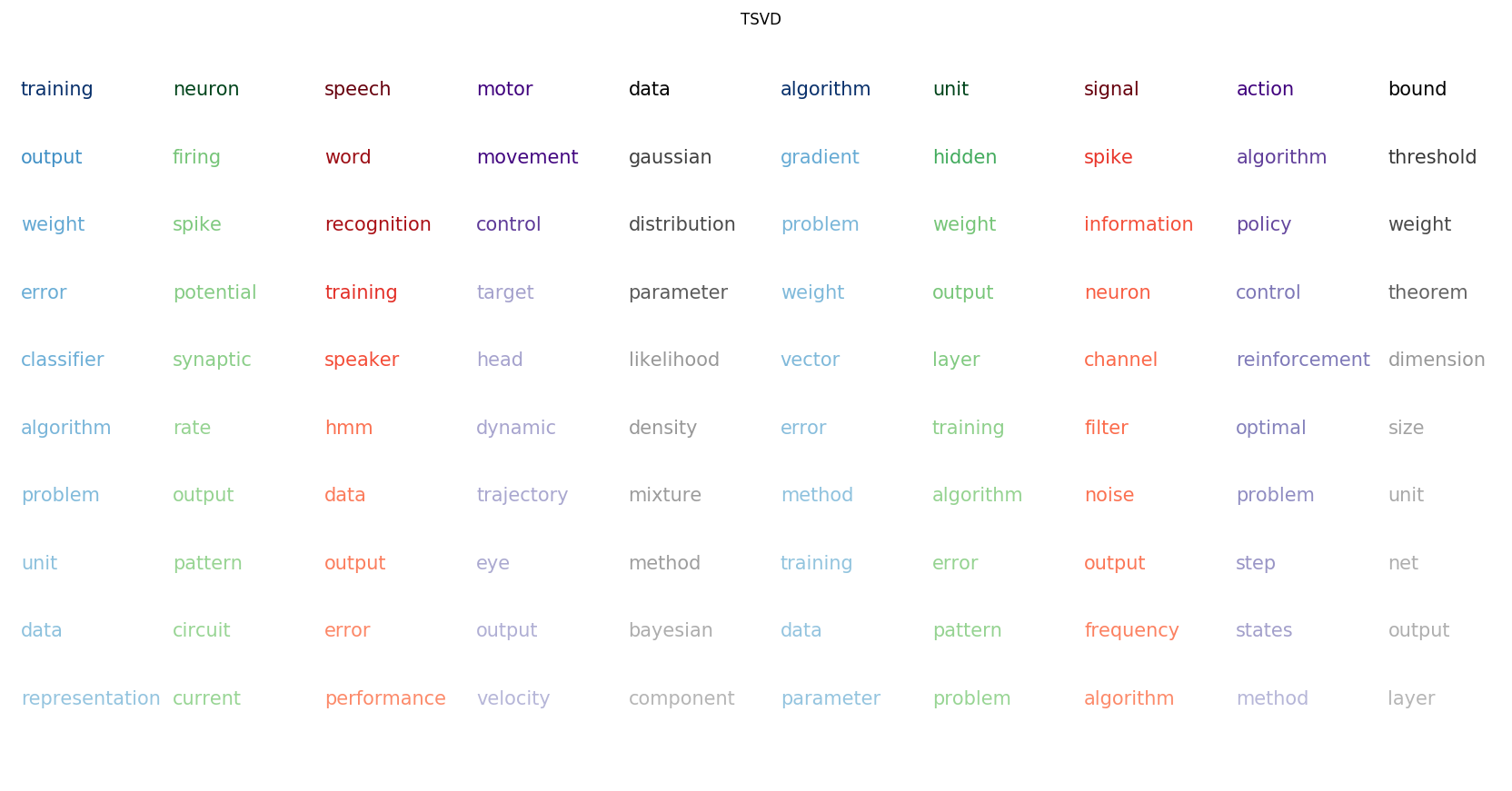
- Plot from model.plot_entropy_distribution
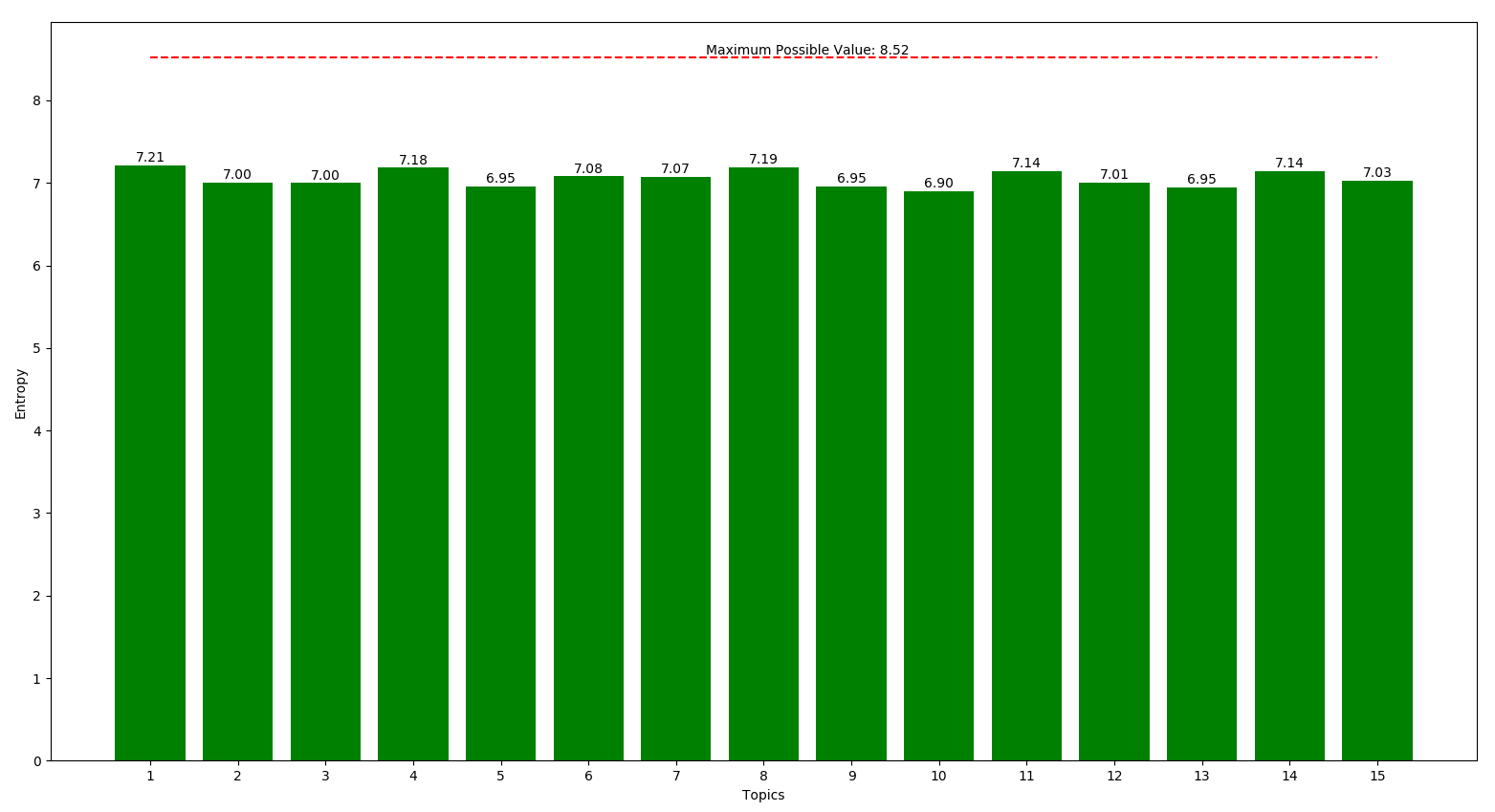
- Plot from model.plot_topic_entropy_colormap
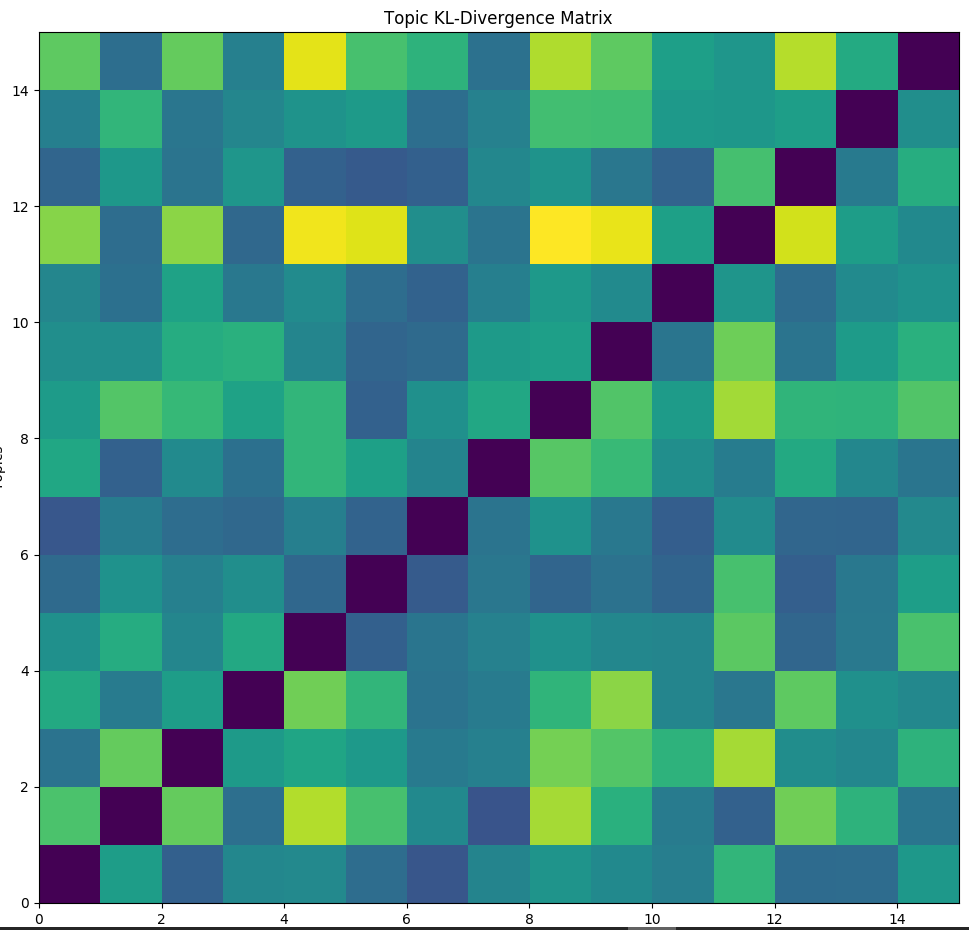
### Case 2
You have corpus in matrix-market format
from topiceval.thresholdedsvd.tsvd import TSVD
model = TSVD(corpus_filepath="<your_corpus_filepath>", vocab_filepath="<your_vocab_filepath>", num_topics = 20)
or, if you have loaded corpus in your program, just use argument *corpus=<your_corpus_variable>*
### Case 3
You have made the A matrix
from topiceval.thresholdedsvd.tsvd import TSVD
model = TSVD(A_matrix_path="<your_Amatrix_filepath>", vocab_filepath="<your_vocab_filepath>", num_topics = 20)
or, if you have loaded Amatrix in your program, just use argument *A_matrix=<your_Amatrix_variable>*
## BCD Topic Model
### Case 1
You have the docword file and vocab file.
from topiceval.dictionarylearning.bcd import BCD
model = BCD(docword_filepath="<your_docword_filepath>", vocab_filepath="<your_vocab_filepath>", num_topics = 20)
# and sparsity, num iterations can be controlled by:
model = BCD(docword_filepath="<your_docword_filepath>", vocab_filepath="<your_vocab_filepath>", num_topics = 20, gamma_frac=0.35, nu_frac=0.15, bcd_iters=10)
### Case 2
You have corpus in matrix-market format
from topiceval.thresholdedsvd.tsvd import TSVD
model = BCD(corpus_filepath="<your_corpus_filepath>", vocab_filepath="<your_vocab_filepath>", num_topics = 20)
or, if you have loaded corpus in your program, just use argument *corpus=<your_corpus_variable>*
### Case 3
You have made the X matrix (num_docs x vocab) or A matrix (vocab x num_docs)
from topiceval.thresholdedsvd.tsvd import TSVD
# for A matrix
model = BCD(A_matrix_path="<your_Amatrix_filepath>", vocab_filepath="<your_vocab_filepath>", num_topics = 20)
# for X matrix
model = BCD(X_matrix_path="<your_Xmatrix_filepath>", vocab_filepath="<your_vocab_filepath>", num_topics = 20)
or, if you have loaded Amatrix in your program, just use argument *A_matrix=<your_Amatrix_variable>*. Similarly for X matrix.
Topiceval is a python library with functionalities to learn topic models (namely gensim LDA, Thresholded SVD, Sparse Coding - Sparse Dictionary Learning) over user mails stored in Outlook with an end interface for user-study on topic quality evaluation, as well as providing topic model classes for usage on independent data-sets.
Added functions include ability to run diagnostics on learned models, which include visualizations on topic-document distribution, topic entropy matrix, topic weights required to cross thresholds etc.
# Requires
- python 3.x or python >= 2.6
- For user-email evaluation - Windows and Outlook
# Dependencies
- scipy>=0.19.0
- gensim
- numpy
- matplotlib
- pandas
- scikit-learn
- nltk (optional)
# Installation
$ pip install topiceval
or
Download from source and "$ python setup.py install" (not yet tested)
# Usage
## User Email Study
$ python -m topiceval
You can also add options:
- -numtopics <int>: Number of topics to learn
- -usethreads <0/1>: Whether to treat each message in threaded conversation as different document (0) or not (1)
- -uselemma <0/1>: Whether to lemmatize words, set to 1 only if you have downloaded wordnet corpora for nltk package.
- -numtopicseval <int>: How many topics out of the learned ones to be shown to the user for evaluation.
- excludefolders <str>: Comma separated name of folders to exclude during mail extraction
- makeWtsvd <0/1>: Whether to make W matrix for TSVD, setting at 1 not yet tested
For example, to learn 20 topics from user mails using lemmatization, excluding folders named 'private' & 'work', and displaying 10 topics for evaluation, you have to use:
$ python -m topiceval -numtopics 20 -numtopicseval 10 -excludefolders private,work -uselemma 1
### User Evaluation Interface

## TSVD Topic Model
### Case 1
You have the docword file and vocab file.
"docword file" is in the format *doc_id word_id word_freq* per each line. Both *doc_id* and *word_id* are 1-indexed
"vocab file" has a vocabulary word in each line, where line number is the word_id.
from topiceval.thresholdedsvd.tsvd import TSVD
model = TSVD(docword_filepath="<your_docword_filepath>", vocab_filepath="<your_vocab_filepath>", num_topics = 20)
learned_M_matrix = model.M_matrix
topic_catchwords = model.topicwise_catchwords
model.save_topic_top_words(filename="tsvdtopics.txt")
model.plot_topic_topwords(topicid_list=range(10))
model.plot_entropy_distribution()
model.plot_topic_entropy_colormap()
model.save_M_matrix(filename="<desired_filepath>")
### Outputs
The following are outputs for TSVD models on NIPS dataset from UCI BoW repository
- Snap from text file made by model.save_topic_topwords:

- Plot from model.plot_topic_topwords

- Plot from model.plot_entropy_distribution

- Plot from model.plot_topic_entropy_colormap

### Case 2
You have corpus in matrix-market format
from topiceval.thresholdedsvd.tsvd import TSVD
model = TSVD(corpus_filepath="<your_corpus_filepath>", vocab_filepath="<your_vocab_filepath>", num_topics = 20)
or, if you have loaded corpus in your program, just use argument *corpus=<your_corpus_variable>*
### Case 3
You have made the A matrix
from topiceval.thresholdedsvd.tsvd import TSVD
model = TSVD(A_matrix_path="<your_Amatrix_filepath>", vocab_filepath="<your_vocab_filepath>", num_topics = 20)
or, if you have loaded Amatrix in your program, just use argument *A_matrix=<your_Amatrix_variable>*
## BCD Topic Model
### Case 1
You have the docword file and vocab file.
from topiceval.dictionarylearning.bcd import BCD
model = BCD(docword_filepath="<your_docword_filepath>", vocab_filepath="<your_vocab_filepath>", num_topics = 20)
# and sparsity, num iterations can be controlled by:
model = BCD(docword_filepath="<your_docword_filepath>", vocab_filepath="<your_vocab_filepath>", num_topics = 20, gamma_frac=0.35, nu_frac=0.15, bcd_iters=10)
### Case 2
You have corpus in matrix-market format
from topiceval.thresholdedsvd.tsvd import TSVD
model = BCD(corpus_filepath="<your_corpus_filepath>", vocab_filepath="<your_vocab_filepath>", num_topics = 20)
or, if you have loaded corpus in your program, just use argument *corpus=<your_corpus_variable>*
### Case 3
You have made the X matrix (num_docs x vocab) or A matrix (vocab x num_docs)
from topiceval.thresholdedsvd.tsvd import TSVD
# for A matrix
model = BCD(A_matrix_path="<your_Amatrix_filepath>", vocab_filepath="<your_vocab_filepath>", num_topics = 20)
# for X matrix
model = BCD(X_matrix_path="<your_Xmatrix_filepath>", vocab_filepath="<your_vocab_filepath>", num_topics = 20)
or, if you have loaded Amatrix in your program, just use argument *A_matrix=<your_Amatrix_variable>*. Similarly for X matrix.
Project details
Release history Release notifications | RSS feed
Download files
Download the file for your platform. If you're not sure which to choose, learn more about installing packages.
Source Distribution
topiceval-1.1.0.dev1.tar.gz
(402.3 kB
view hashes)











